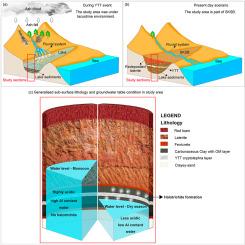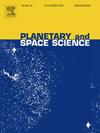Formation of halotrichite in the South Kerala Sedimentary Basin, SW India: Implications for Martian paleo-environmental studies
IF 1.7
4区 物理与天体物理
Q3 ASTRONOMY & ASTROPHYSICS
引用次数: 0
Abstract
Halotrichite [FeAl2(SO4)4·22(H2O)] is a rare secondary sulfate mineral with its occurrence confined within the sulfide weathering zones. In the South Kerala Sedimentary Basin (SKSB) of SW India, halotrichite, here reported for the first time, is associated with an organic matter (OM)-rich carbonaceous clay layer. Field investigation revealed the prevalence of acid rock drainage (ARD) conditions similar to Martian analogue sites like Rio Tinto. The OM-layer is associated with pyrite forming substratum and Al-rich leachate associated with the Youngest Toba Tuff (YTT) cryptotephra layer. Oxidation of these units results in the formation of halotrichite, which is temporally restricted only to the dry season when the water table lowers and the OM-layer is exposed to air. X-Ray Diffraction (XRD) results for halotrichite show the presence of Al and Fe(II) sulfates. Energy Dispersive X-ray Spectroscopy (EDS) ruled out the existence of pickeringite, the Mg end-member of halotrichite-pickeringite series. XRD results for the OM-layer indicate the presence of kaolinite, quartz, goethite, and lepidocrocite. Hyperspectral analysis of the clay samples confirms that halotrichite is associated with goethite, lepidocrocite, kaolinite, and smectite. Fourier Transform Infrared Spectroscopy (FTIR) analysis revealed the major constituent of the clay sample as kaolinite with traces of quartz, smectite, and OM. Raman spectrum of halotrichite shows the symmetric stretching vibration of SO42− bonded to Fe2+. Association of halotrichite with Fe, Al, and S-rich minerals is also inferred by the study of Raman spectrum of the host clay. Co-existence of halotrichite, goethite, lepidocrocite, and phyllosilicates in the study area is similar to the mineral assemblage found along the Rio Tinto River. On Mars, halotrichite is associated with the layered sulfate deposits, such as those in Valles Marineris and Meridiani Planum, and is categorized as a polyhydrated sulfate. Hence, this study on the halotrichite mineralization in the SKSB can supplement the attempts on deciphering the deposition and formation environment of similar mineralization on Mars.

印度西南部南喀拉拉沉积盆地光卤石的形成:对火星古环境研究的影响
光卤石[FeAl2(SO4)4-22(H2O)]是一种罕见的次生硫酸盐矿物,只出现在硫化物风化带中。在印度西南部的南喀拉拉邦沉积盆地(SKSB),光卤石首次与富含有机质(OM)的碳质粘土层伴生。实地调查显示,酸性岩石排水(ARD)条件与力拓等火星类似地点相似。OM 层与黄铁矿形成的基底层以及与最年轻的多巴凝灰岩(YTT)隐晶质层相关的富铝浸出液有关。这些单元的氧化作用会形成卤黄铁矿,而卤黄铁矿在时间上仅限于旱季,因为旱季时地下水位降低,OM 层暴露在空气中。光卤石的 X 射线衍射(XRD)结果显示存在铝和硫酸铁(II)。能量色散 X 射线光谱(EDS)排除了光卤石-黝帘石系列的镁末端成员黝帘石的存在。OM 层的 XRD 结果表明存在高岭石、石英、网纹石和鳞片石。粘土样品的高光谱分析证实,光卤石与网纹石、鳞片石、高岭石和直闪石相关联。傅立叶变换红外光谱(FTIR)分析表明,粘土样品的主要成分是高岭石,还有微量的石英、直闪石和 OM。光卤石的拉曼光谱显示了与 Fe2+ 结合的 SO42- 的对称伸缩振动。通过对主粘土拉曼光谱的研究,还可以推断出光卤石与富含铁、铝和 S 的矿物的关联。在研究区域,光卤石、网纹石、鳞片石和植硅酸盐共存,这与在力拓河沿岸发现的矿物组合相似。在火星上,光卤石与层状硫酸盐矿床有关,如海洋谷(Valles Marineris)和子午线(Meridiani Planum)的硫酸盐矿床,被归类为多水合硫酸盐。因此,对 SKSB 中光卤石成矿作用的研究可以补充对火星上类似成矿作用的沉积和形成环境的解密尝试。
本文章由计算机程序翻译,如有差异,请以英文原文为准。
求助全文
约1分钟内获得全文
求助全文
来源期刊

Planetary and Space Science
地学天文-天文与天体物理
CiteScore
5.40
自引率
4.20%
发文量
126
审稿时长
15 weeks
期刊介绍:
Planetary and Space Science publishes original articles as well as short communications (letters). Ground-based and space-borne instrumentation and laboratory simulation of solar system processes are included. The following fields of planetary and solar system research are covered:
• Celestial mechanics, including dynamical evolution of the solar system, gravitational captures and resonances, relativistic effects, tracking and dynamics
• Cosmochemistry and origin, including all aspects of the formation and initial physical and chemical evolution of the solar system
• Terrestrial planets and satellites, including the physics of the interiors, geology and morphology of the surfaces, tectonics, mineralogy and dating
• Outer planets and satellites, including formation and evolution, remote sensing at all wavelengths and in situ measurements
• Planetary atmospheres, including formation and evolution, circulation and meteorology, boundary layers, remote sensing and laboratory simulation
• Planetary magnetospheres and ionospheres, including origin of magnetic fields, magnetospheric plasma and radiation belts, and their interaction with the sun, the solar wind and satellites
• Small bodies, dust and rings, including asteroids, comets and zodiacal light and their interaction with the solar radiation and the solar wind
• Exobiology, including origin of life, detection of planetary ecosystems and pre-biological phenomena in the solar system and laboratory simulations
• Extrasolar systems, including the detection and/or the detectability of exoplanets and planetary systems, their formation and evolution, the physical and chemical properties of the exoplanets
• History of planetary and space research
 求助内容:
求助内容: 应助结果提醒方式:
应助结果提醒方式:


